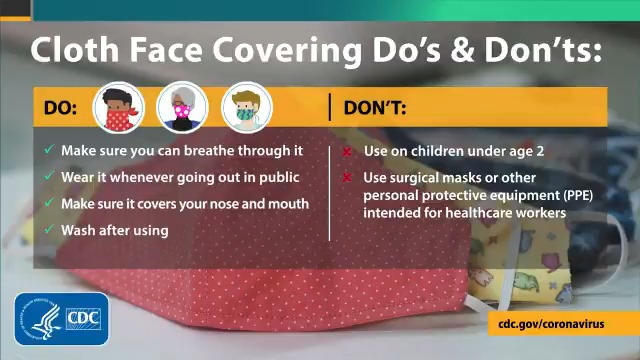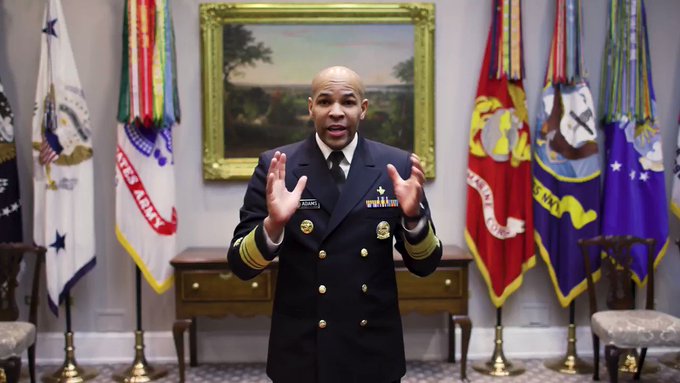
Practicing social distancing, customers wearing masks during the coronavirus pandemic while waiting to enter a Wells Fargo Bank branch Tuesday, April 14, 2020, in Aurora, Colo. (AP Photo/David Zalubowski)
After the Centers for Disease Control and Prevention (CDC) reversed its stance on the use of masks as protection against the new coronavirus and other leading world health experts at the World Health Organization (WHO) followed suit, many Americans have struggled to find and purchase masks or have had to resort to making one of their own.
Even though officials and health experts have recommended against N95 respirators, in order to leave those available for health care workers on the front lines of the COVID-19 battle, leading medical professionals have offered up tips and practical guidance to help people and their families get the maximum amount of protection out of face coverings possible.
Following social distancing practices, stay-at-home orders and proper hand-washing are still considered critical prevention methods, even when wearing a mask, and experts have emphasized that wearing a mask does not make anyone immune to SARS-CoV-2, the virus that causes COVID-19.
Who is required to wear masks?
President Donald Trump announced in early April that the CDC is now recommending Americans cover their faces with “non-medical cloth” masks when venturing into public. Trump said during a briefing at the White House that people should refrain from using medical masks and allow them to be reserved for health care workers. The masks are to be used alongside social distancing methods, not as a replacement for them.
Many individual states and cities are also instituting methods and requirements for wearing masks.
All people in New York have been ordered to wear face masks in public. Gov. Andrew Cuomo issued an executive order that requires people to wear a face mask or face covering while in public, according to CNBC.
Washington, D.C., extended an emergency order which included that face masks are required for hotel workers, people using taxis, workers and customers of food sellers and workers and individuals using public transit.
Pennsylvanians were also told to wear masks whenever leaving their home. Gov. Tom Wolf recommended that everyone across the state wear a mask any time that they must leave their residence for life-sustaining reason.
People in the city of Laredo, Texas, who enter a building outside of their home face a fine of up to $1,000 if they're not wearing a mask, according to the Laredo Morning Times. Bandanas, scarfs or other types of fabric are acceptable to wear in the city, located along the Texas-Mexico border.
The city of Miami issued an emergency order earlier in April, mandating all employees and customers at grocery stores and pharmacies to wear face masks, according to The Miami Herald. The order, signed by City Manager Art Noriega, is intended to help control the rapid spread of COVID-19 in the city, which is the hardest-hit in Florida. The order also requires delivery workers to wear masks.
What is the recommended method to wearing a mask?
The CDC has issued some basic do's and don'ts for proper face-covering usage.
Do:
- Make sure you can breathe through it.
- Wear it whenever going out in public.
- Make sure it covers your nose and mouth.
- Wash after using.
Don't:
- Use if under 2 years old.
- Use surgical masks or other PPE intended for
healthcare workers.
The CDC also posted the recommendations in a video that can be seen below:
The CDC also issued new safety practices for people who are unable to telecommute and who think that they have been potentially exposed to the coronavirus. “A potential exposure means being a household contact or having close contact within 6 feet of an individual with confirmed or suspected COVID-19,” the CDC said. The practices include:
- Pre-screen: Employers should measure the temperatures of employees before entering the facility.
- Wear a mask: Employees should wear a face mask at all times while in the workplace for at least 14 days since possible exposure.
- Social distance: Employees should remain at least 6 feet away from other workers.
- Clean work spaces: Work areas should be cleaned and disinfected routinely, including desks, common areas and bathrooms.

A woman wearing a mask walks away from the Life Care Center in Kirkland, Wash., near Seattle, Monday, March 2, 2020, after a second person had died from the coronavirus. (AP Photo/Ted S. Warren)
What is the right way to make a mask?
The CDC has issued instructions on how to make sew and no-sew facemasks at home using T-shirts, coffee filters and bandanas. The federal agency also provided comprehensive steps on how to most effectively wear homemade face masks and how to safely remove and sterilize a cloth mask.
U.S. Surgeon General Jerome Adams posted a 45-second video demonstrating how to make a homemade face mask . Watch it below.
Additionally, the CEO of a Los Angeles boutique found that the improvement to the DIY cotton masks people are making at home lies in blue shop towels. By placing a layer of the fabric between two layers of cotton, Lindsay Medoff, CEO of Suay Sew Shop found that the new masks could filter out up to 95% of the particles they could test, compared to the 20% to 60% of the particles that cotton alone could filter, according to Business Insider. Medoff has tested ToolBox’s shop towels and ZEP’s industrial blue towels.
RELATED:
How long will we have to wear masks?
Masks might be a fixture on American faces through late 2021, one expert told AccuWeather. Dr. Shan Soe-Lin of Yale University said she believes they should be worn in all circumstances, and that the face coverings will be needed not just in the short-term, but through the peak and downslope until a vaccine is introduced to the public, which could be 12 to 18 months away. She also speculated on why Americans have been slow to adopting the practice of mask-wearing.
"I think people are going to have to wear masks until there's a vaccine. I mean that to be completely blunt," said Shan.
How many people are wearing masks?
AccuWeather polled readers early in April on whether they had adopted face mask-wearing when venturing into public.
Overall, 61% of respondents indicated that they were wearing a mask in public. Some 37.1% responded that they are wearing a mask, while 24% responded that they are wearing a mask and gloves. A significant 33.9% said they are not wearing a mask or gloves, and 5% indicated they are wearing gloves only. The poll, which is not scientific, also sparked some conversation on Twitter. Here are five quotes from readers that caught our eye:
• "I wear a mask when I go to the store. Only go out to store about once a week."
• "Wearing gloves at work and washing my hands in the gloves like 50 times a day, without the gloves I think my hands would just be bones now lol."
• "Not going out so not wearing unless an outing comes up. Have mask for Dr. visits or groceries in rural community."
• "No I don't have one. I can't get one around here in rural Alabama."
• "Not going to do it. Not living like that."
Keep checking back on AccuWeather.com and stay tuned to the AccuWeather Network on DirecTV, Frontier and Verizon Fios.





No comments:
Post a Comment